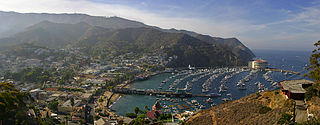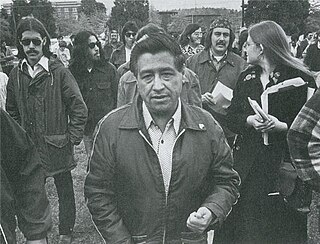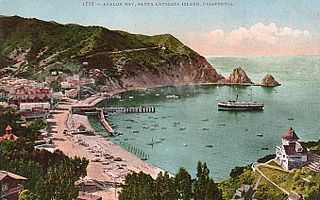
Avalon is the only incorporated city on Santa Catalina Island, in the California Channel Islands, and the southernmost city in Los Angeles County. The city is a resort community with the waterfront dominated by tourism-oriented businesses. The older parts of the town on the valley floor consist primarily of small houses and two and three-story buildings in various traditional architectural styles.

The Channel Islands are an eight-island archipelago located within the Southern California Bight in the Pacific Ocean, off the coast of California. The four Northern Channel Islands are part of the Transverse Ranges geologic province, and the four Southern Channel Islands are part of the Peninsular Ranges province. Five of the islands are within the Channel Islands National Park, and the waters surrounding these islands make up Channel Islands National Marine Sanctuary. The Nature Conservancy was instrumental in establishing the Channel Islands National Marine Sanctuary.

The Chicano Moratorium, formally known as the National Chicano Moratorium Committee Against The Vietnam War, was a movement of Chicano anti-war activists that built a broad-based coalition of Mexican-American groups to organize opposition to the Vietnam War. Led by activists from local colleges and members of the Brown Berets, a group with roots in the high school student movement that staged walkouts in 1968, the coalition peaked with a August 29, 1970 march in East Los Angeles that drew 30,000 demonstrators. The march was described by scholar Lorena Oropeza as "one of the largest assemblages of Mexican Americans ever." It was the largest anti-war action taken by any single ethnic group in the USA. It was second in size only to the massive U.S. immigration reform protests of 2006.

The Brown Berets is a pro-Chicano paramilitary organization that emerged during the Chicano Movement in the late 1960s. David Sanchez and Carlos Montes co-founded the group modeled after the Black Panther Party. The Brown Berets was part of the Third World Liberation Front. It worked for educational reform, farmworkers' rights, and against police brutality and the Vietnam War. It also sought to separate the American Southwest from the control of the United States government.

The Chicano Movement, also referred to as El Movimiento, was a social and political movement in the United States that worked to embrace a Chicano/a identity and worldview that combated structural racism, encouraged cultural revitalization, and achieved community empowerment by rejecting assimilation. Chicanos also expressed solidarity and defined their culture through the development of Chicano art during El Movimiento, and stood firm in preserving their religion.

The East Los Angeles Walkouts or Chicano Blowouts were a series of 1968 protests by Chicano students against unequal conditions in Los Angeles Unified School District high schools. The first walkout occurred on March 5, 1968. The students who organized and carried out the protests were primarily concerned with the quality of their education. This movement, which involved thousands of students in the Los Angeles area, was identified as "the first major mass protest against racism undertaken by Mexican-Americans in the history of the United States".

Salvador B. Castro was a Mexican-American educator and activist. He was most well known for his role in the 1968 East Los Angeles high school walkouts, a series of protests against unequal conditions in Los Angeles Unified School District (LAUSD) schools. After he retired from teaching, he continued to lecture about his experiences and the importance of education, especially for Mexican Americans.

Luis Javier Rodriguez is an American poet, novelist, journalist, critic, and columnist. He was the 2014 Los Angeles Poet Laureate. Rodriguez is recognized as a major figure in contemporary Chicano literature, identifying himself as a native Xicanx writer. His best-known work, Always Running: La Vida Loca, Gang Days in L.A., received the Carl Sandburg Literary Award and has been controversial on school reading lists for its depictions of gang life.

The Catalina Island Conservancy is a nonprofit organization established to protect and restore Santa Catalina Island, California, United States. The Conservancy was established in 1972 through the efforts of the Wrigley and Offield families. The Conservancy was created when both families deeded 42,135 acres (170.51 km2) of the island over to the organization—88% of the Island.
Las Adelitas de Aztlán was a short-lived Mexican American female civil rights organization that was created by Gloria Arellanes and Gracie and Hilda Reyes in 1970. Gloria Arellanes and Gracie and Hilda Reyes were all former members of the Brown Berets, another Mexican American Civil rights organization that had operated concurrently during the 1960s and 1970s in the California area. The founders left the Brown Berets due to enlarging gender discrepancies and disagreements that caused much alienation amongst their female members. The Las Adelitas De Aztlan advocated for Mexican-American Civil rights, better conditions for workers, protested police brutality and advocated for women's rights for the Latino community. The name of the organization was a tribute to Mexican female soldiers or soldaderas that fought during the Mexican Revolution of the early twentieth century.

The Occupation of Alcatraz was a 19-month long protest when 89 Native Americans and their supporters occupied Alcatraz Island. The protest was led by Richard Oakes, LaNada Means, and others, while John Trudell served as spokesman. The group lived on the island together until the protest was forcibly ended by the U.S. government.

Santa Catalina Island is a rocky island off the coast of Southern California in the Gulf of Santa Catalina. The island covers an area of about 75 square miles. It features a diverse and rugged landscape, including rolling hills, canyons, coastal cliffs, and sandy beaches. The island's highest peak is Mount Orizaba, rising to an elevation of 2,097 feet. The island is 22 mi long and 8 mi across at its largest width. The island is situated in the Pacific Ocean, approximately 29 mi south-southwest of Long Beach, California. Politically, Catalina Island is part of Los Angeles County in District 4. Most of the island's land is unincorporated and is thus governed by the county.

August 1972 was the eight month of that leap year. It began on a Tuesday and ended after 31 days on a Thursday. The following events occurred in August 1972:

The Tuna Club of Avalon is a private members's club in Avalon on Santa Catalina Island in California.

Mexican Americans have lived in Los Angeles since the original Pobladores, the 44 original settlers and 4 soldiers who founded the city in 1781. People of Mexican descent make up 31.9% of Los Angeles residents, and 32% of Los Angeles County residents.

The history of human activity on Santa Catalina Island, California begins with the Native Americans who called the island Pimugna or Pimu and referred to themselves as Pimugnans or Pimuvit. The first Europeans to arrive on Catalina claimed it for the Spanish Empire. Over the years, territorial claims to the island transferred to Mexico and then to the United States. During this time, the island was sporadically used for smuggling, otter hunting, and gold-digging. Catalina was successfully developed into a tourist destination by chewing gum magnate William Wrigley, Jr. beginning in the 1920s, with most of the activity centered around the only incorporated city of Avalon, California. Since the 1970s, most of the island has been administered by the Catalina Island Conservancy.
Gloria Arellanes is a political activist known for her involvement with the Brown Berets during the Chicano Movement and has been influential in the development of Chicana feminism. As the first female Prime Minister of the Brown Berets, Arellanes worked to include the Chicana perspective in fighting for Mexican rights in Los Angeles in the 1960s and 1970s. Conflicts of covert "macho attitude" within the delegation of labor in the Brown Berets led Gloria Arellanes along with other female Brown Berets to leave the organization and create Las Adelitas de Aztlán. Similar to the Brown Berets, Las Adelitas de Aztlán strived to assist its community members in creating awareness for better bilingual education in Los Angeles as well as protesting against the Vietnam War. Arellanes was also a prominent figure in the National Chicano Moratorium Committee, leading Las Adelitas de Aztlán to participate in marches against the violence of the Vietnam War.
The Brown Berets was a Chicano/Mexican-American community-based organization in Austin, Texas founded during the Chicano Civil Rights Movement, modeled after the Brown Berets.
Victoria "Vickie" Castro is an American educator and political activist known for her work with the Young Citizens for Community Action, Brown Berets, and the East L.A. walkouts. Castro went on to work for the Los Angeles Unified School District, and eventually ran for office becoming a member of the LA School Board.

David Sanchez is an American civil rights activist, and founding member of the Brown Berets. In the 1960s and 70s he was heavily involved in the Chicano civil rights and political movements.















